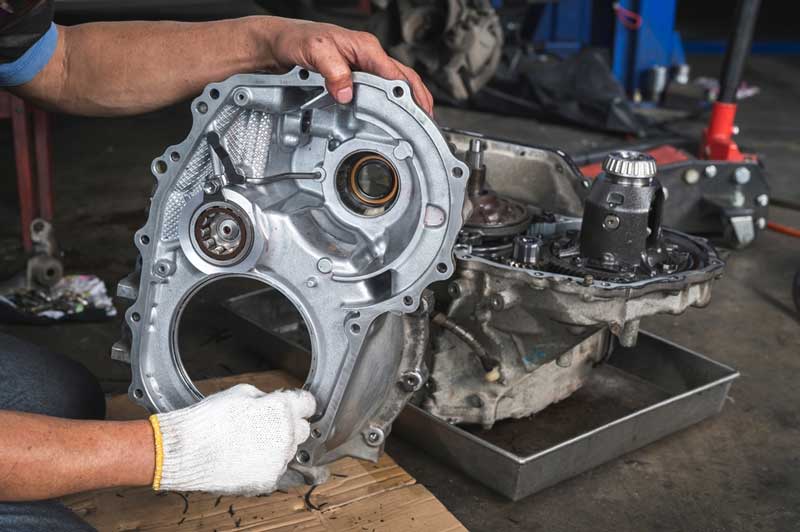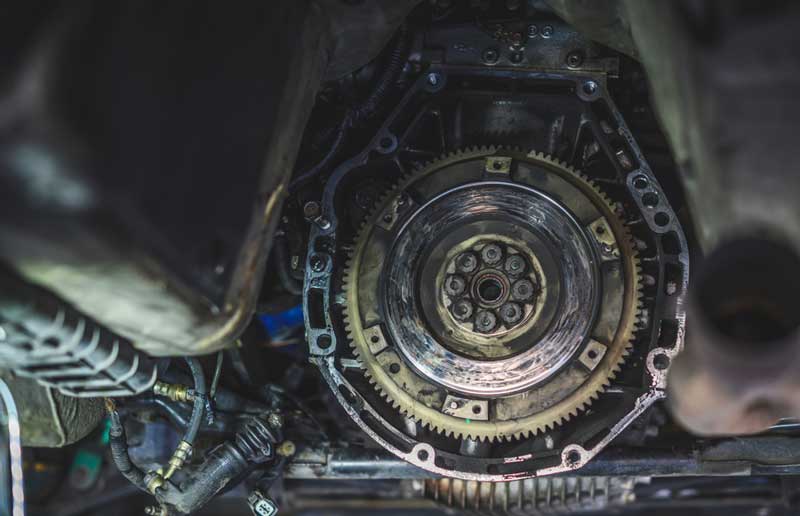Is your Transmission Slipping? Would you like to know what might have caused such and how to fix this issue?
Nearly all vehicle owners are scared at the mention of transmission issues. Most of them instantly think that their vehicle will be held up in a repair shop for a couple of weeks, with thousands pilling up as amounts for repairs.
Unfortunately, such is the case sometimes, yet slipping transmission is not invariably the worst scenario.
There may be an easy solution to the issue most times. Continue reading to discover seven reasons your transmission may be slipping and offer tips for repair and cost estimates.
Let’s get started!
What is Transmission Slipping
Transmission slipping” simply refers to a situation when your transmission “slips” out of gear. This simply means it changes from one gear to another without you shifting the gears. It often occurs when you shift gears, and it often slips into neutral
Common Reasons for A Transmission Slipping
You perhaps have observed that your transmission is slipping, yet you may be pondering what could have caused it. Below are a few typical causes of transmission problems. Subsequently, the steps to fix the issue will be explained.
1. Transmission Fluid is Low or Old.
Automatic transmission fluid happens to be a very important part of the effective functioning of your transmission. Where the fluid level is low, it may result in myriad issues. Also, contaminated or burnt fluid will surely cause problems. Pollutants inside the fluid may result in overheating and cause other serious issues as well. Therefore, your routine maintenance schedule should regularly include a transmission fluid flush or a transmission fluid change.
Normally, this ought to be carried out between 40,000 to 50,000 miles. Your fluid should be blooming and not have a burning scent. When your transmission fluid is low, inspect for a transmission fluid leakage and observe your fluid level.
2. Bands are Worn or Broken
Bands in your transmission are supposed to be tightly fit as they go round the switch gears. However, the bands become worn out and get loose when they are used frequently. Sometimes, they break down entirely. Failure in transmission or failure in shifting gears is the problem caused by broken bands, while worn bands can cause transmission slipping. Most times, the bands may be modified to fit in tightly again. In other cases, the transmission may require an entire rebuild.
3. Software Problems
Your car’s transmission depends on parts other than the solenoid, torque converter, or valve body to perform perfectly. The role played by the vehicle’s computer is also huge.
To assist in controlling the transmission, the vehicle’s computer monitors the fluid pressure, speed, throttle position, and other necessary means to assist in controlling the transmission.
At times, the operating system in your vehicle’s computer may not function properly, resulting in transmission problems such as missed shifts or slipping.
Analyzing the issue may not be easy, yet a car repair store can quickly flash the ECM with fresh software soundly. Sometimes, a check engine light may pop up if you’ve got computer issues.
4. Bad Torque Converter
The torque converter is the transmission section that links exactly to the engine. Torque converter problems could result in the engine not transmitting power through the transmission perfectly as it should. This may begin to appear as a transmission slipping problem and become worse with time. Torque converters are the culprits whenever you discover your transmission slipping.
5. Improperly Working Clutch
Automatic transmissions have clutches just as manual transmissions have. And in most cases, the clutches function similarly.
Whenever the clutch in your transmission isn’t performing optimally, you may sense improper shifting or Transmission slipping problems. A dependable repair store can assist you in determining the precise issue and discovering if the clutch is the problem.
6. Usual Wear and Tear
You may still experience issues, even when you have performed the necessary maintenance and have fixed your transmission issues. This is because the transmission will not last indefinitely.
Also, overuse will normally lead to issues. For example, the clutch will start to become worn, the bands may begin to lax, and the gears may wear out. The longer you use your car, the more likely you will eventually repair your transmission.
7. Failure of Solenoid
The fluid diffused via the transmission is controlled with the help of the transmission’s solenoid. As discussed earlier, transmission fluid is very important to correctly function your transmission.
Solenoid issues could result in transmission slippage, decreased hydraulic fluid pressure, and other problems. A constantly decreased transmission fluid level can also cause Transmission Solenoid problems.
Also Read: Head Gasket Replacement Cost
Basics of Automatic Transmission
Although car owners find it easy to use automatic transmission, it is very complex equipment. Drivers push the transmission to drive and press the gas pedal. The transmission adjusts gears irrespective of the driver’s effort. Nevertheless, there are lots of activities that make it happen.
There are many complicated components inside the Automatic transmission. These components are transmission bands, check balls, gears, clutches, and many other parts. Automatic transmission fluid lubricates the components inside and applies pressure to precise components inside the transmission.
Transmission fluid is spun into the trajectory of the transmission by a torque converter connected to the engine’s flywheel. Of course, the vehicle’s computer is part of the process also. It communicates to the transmission just when to adjust, the gear to change, and how hard it should change.
Although this narrative is from a high-level transmission standpoint, it offers a hint of simply how complex it is. Manual transmissions are not, however, as complicated. Though they have plenty of moving parts, their function is not almost as complex. The car driver steps on the clutch bar and adjusts to the appropriate gear every time. Although more effort is required from the driver using manual transmission, they tend not to cause problems like the automatic transmission.

How Does a Slipping Transmission Feel?
Transmission Slipping, what does it feel like? Maybe your car looks a bit irregular as you drive it; you may not be exactly certain what the problem is. Slipping the transmission will likely feel like the car is surging or jerking. Amidst gear changes, you may observe that your engine fires up to an increased RPM. Just as you drive, the transmission should provide consistent power to the wheels. If the transmission begins to slip, it appears no power is transmitted to the wheels.
You will observe that the vehicle does not have adequate power for accelerated intervals whenever this happens. Thus, this causes the surging or jerking motion you may notice in your car. That is the major sign that characterizes slipping transmission. Slipping transmission may also have issues adjusting gears.
This is the reason you may feel your RPM revving higher between shifts. Furthermore, the transmission will have issues whenever it quickly changes from each to the other; also, the prolonged pause offers the engine the time to fire up till the power is sent again into the wheels via the transmission. You may also hear abnormal sounds such as a clunking noise if the transmission tries to adjust.
Also Read: Temporary Fix for Crankshaft Position Sensor (Expert Guide)
How To Fix a Slipping Transmission
Flushing or changing the fluid may be expected to be the first thing to do in repairing a transmission slipping problem, yet that is not always the case.
Whenever there is a slipping transmission, it is most likely that there is an internal component that is worn. Sometimes, friction component from things like the clutch pedal may be floating amid the used fluid or has worn off.
Though it appears to be bad, that friction component may still be helping with causing the needed friction. Where that fluid gets changed, the result may even be worse slipping.
Furthermore, putting new fluid into soiled fluid may move contaminants and particles around, thus damaging the transmission further.
At this stage, you may try experimenting with a product like Lucas Transmission Fix Slip; nevertheless, it rarely works. Expert analysis is always required whenever your transmission becomes bad. Although transmissions can be fixed and rebuilt, repairs are usually left to professionals due to their complexity. Sadly, transmission repairs could be very expensive.
The appropriate step to avoid faulty fluid is by carrying out a replacement, and/or every 40,000 miles, you flush roughly, or at certain periods the manufacturer specifies when the fluid still appears decent.
What Does a Slipping Transmission Repair Cost?
Transmission issues are usually expensive because it needs professionals to repair them, and the time put into repairing them will also be considered. If you are going to just do a mere fluid flush, it should cost around 250 dollars. It will cost you below 100 dollars, however, if you carry out the fluid change yourself.
The cost will likely increase if all these don’t resolve the problem. Where a major repair is needed, such as rebuilding the transmission, you should get an estimate of between 1,500 and 2,000 dollars. Carrying out such repairs in high-end cars will be more expensive.
Needing a brand new transmission is probably the worst that can happen. A brand new transmission costs between 3,000 to 5,000 dollars. At this point, you ought to consider seriously whether your vehicle is worth all that amount. You may sell it off as scrap and purchase a new one that does not have transmission issues.
Is It Safe to Drive Your Vehicle When the Transmission Is Slipping?
The soundness of the car is very unpredictable whenever it has a transmission problem; hence it is advisable not to drive the car. Sometimes, it might slip into other gears without any warning signal or shaking or even create serious damage.
Thus, check out your car immediately if you notice the symptoms or signs of slipping transmissions.

How to Check Transmission Slipping
You can avoid transmission slipping, yet you should be certain that worn-out bands or fluids leaks are not the cause of the issue. Where they are the cause, you might need to change the Solenoids, the broken-down gears, the torque converter, or the clutch.
If an expert carries out the repairs for you, it will definitely be expensive. Therefore, it is important to explore other possibilities first because it will not be favorable to have in your possession an old vehicle.
Your car’s onboard analytic computer can update you on any issue if you possess a new car. It is mostly the case if the solenoid appears to be the cause of the transmission issue. Nevertheless, when your new car sends an error code, inspect them first to determine the information concerning the state of your transmission.
Consider checking your transmission bands when you can’t point out the issue despite all these. Change any broken or worn transmission band. If you need to change one band, change all of them. This helps to avoid confronting the same problem within a short period.
You might also want to check properly to confirm the transmission fluid’s state. First, make sure the fluid is at the proper level. Endeavor to locate the main source of any leakage whenever your transmission fluid is lower than normal.
You may find holes in a fluid line or discover that one seal has become loose. Your transmission pan may also develop a leak, or the transmission pan gasket can be faulty.
If you want to drive, you can change these faulty components yourself. Nevertheless, if you find a broken torque converter, professionals will be needed to examine it and repair it wholistically.
Identify the source or origin of the leak and repair it quickly. You may also need to add a perfect transmission leak sealing solution when next you top up your transmission fluid.
Also Read: Car Blowing White Smoke After Oil Change (Causes & Fix)
Frequently Asked Questions – Transmission Slipping
What does a slipping transmission feel like?
Slipping transmission happens to sense like the car is surging or jerking. You may discover that your engine fires up to an increased RPM between changing gears. The transmission should provide continuous power to the wheels as you drive.
What causes transmission slipping?
Causes of slipping transmission. Burnt or low transmission fluid is the commonest cause of transmission slipping. It could also be caused by a damaged torque converter, an overuse transmission band, or damaged shift solenoids. On very rare occasions, a faulty TCM could cause it.
Can you drive a car with a slipping transmission?
Briefly put, you should not allow anyone to drive your car if you know that the car has a transmission problem. Whenever a transmission begins to slip, it requires immediate repairs. It is risky each time you drive your vehicle after you sense that you have a slipping transmission.
Can you fix a slipping transmission at home?
Where a decreased fluid level causes the transmission slip or because of leakage, then you might be capable of repairing it yourself by examining and replacing your fluid or rather by plugging/repairing the leakage.
Will a transmission fluid change fix slipping?
You will need to top up more fluid to fix the issue of decreased fluid levels. For damaged or burnt fluid, you will require to flush the used fluid and change it with brand new fluid. However, in case of a leakage, part of the transmission must be drained to avoid further transmission and slipping issues.
Will a transmission flush help slipping?
Can a Transmission Flush Fix Slipping? Of course, the fluid may be the problem, whether it is too high or is contaminated. Nevertheless, a flush normally is carried out with an expert’s machine in a repair store; thus, it is not a simple thing that can be done at home in the garage.
Can dirty transmission fluid cause slipping?
If the transmission fluid has become contaminated, old, and/or low, it’ll quicken the wear and tear on the gears. This could cause them not to engage effectively, leading to transmission slipping.
Conclusion – Transmission Slipping
If you have a transmission slipping problem, you might easily become agitated to attempt fixing it yourself. However, the best option is to let an expert or professional fix the slipping issues for you whenever you notice that you are incapable of fixing the transmission problem yourself.
Transmission experts have the required experience and equipment to determine the causes of the transmission slipping.
Immediately they detect the issue, they will quickly repair it within a couple of hours or days so that you return to your everyday lifestyle.

